PROGRESS AND RESULTS OF RESEARCH WORK
EVOLUTION OF INVENTIONS
Speaking about science and invention, Einstein once said
something that could be literally applied to the invention of perpetuum
mobile and antigravitational
motor:
Scientists - says Einstein - establish
and legitimise something, and then a child is born who knows nothing about
that, and a miracle happens.
 As
a boy, Veljko MilkoviŠ lived
in Telep, suburban part of Novi
Sad (Serbia). At that time, life was hard, but social life was highly
developed. Children did not have toys, there was no television, and other
passive forms of entertainment. Children created their own world. A large
number of children gathered every day around toys they made themselves.
One day, Veljko also had an idea - that was his first invention - to make
a vehicle that would move on its own. He put a small plank on the ground,
which leaned on two small and one bigger ball. He put a glass stopper on
the plank. When out of balance, the stopper could oscillate for a time,
and centrifugal force moved the plank in direction of two smaller balls.
The working principle of this machine is the same as with his later invention:
"Cart with a pendulum". In 1954, at the tim
As
a boy, Veljko MilkoviŠ lived
in Telep, suburban part of Novi
Sad (Serbia). At that time, life was hard, but social life was highly
developed. Children did not have toys, there was no television, and other
passive forms of entertainment. Children created their own world. A large
number of children gathered every day around toys they made themselves.
One day, Veljko also had an idea - that was his first invention - to make
a vehicle that would move on its own. He put a small plank on the ground,
which leaned on two small and one bigger ball. He put a glass stopper on
the plank. When out of balance, the stopper could oscillate for a time,
and centrifugal force moved the plank in direction of two smaller balls.
The working principle of this machine is the same as with his later invention:
"Cart with a pendulum". In 1954, at the tim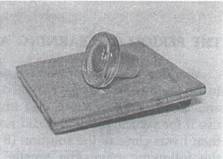 e
of his first invention, he was only 5 years old, and the "Cart
with a pendulum" that have wheels instead of balls was invented
when he was 43, in 1992. This model was the basis for the books in which
he talks about the antigravitational
motor. It seems that the event with a plank and balls predestined
Veljko MilkoviŠ to be the inventor. This event can be confirmed by children
from his neighbourhood (these are grown men now) it has predetermined his
career of an inventor.
e
of his first invention, he was only 5 years old, and the "Cart
with a pendulum" that have wheels instead of balls was invented
when he was 43, in 1992. This model was the basis for the books in which
he talks about the antigravitational
motor. It seems that the event with a plank and balls predestined
Veljko MilkoviŠ to be the inventor. This event can be confirmed by children
from his neighbourhood (these are grown men now) it has predetermined his
career of an inventor.
The invention from 1954 evolved with time. MilkoviŠ invented
"Pendulum with a ball and a weight" in 1963 and "Seesaw
with springs and a ball" in 1966. From 1969 to 1971 he was developing
the model of the "Pendulum with springs and a ball". The
last model connected to the invention from 1954 was the already mentioned
patent: "Cart with a pendulum",
from 1992.
There is a direct link between the invention from 1954
and the model named "Mechanical
hammer with physical pendulum". Both inventions are two-stage
oscillators. Both use gravitational force. With the first one, gravity is
moving the glass stopper, and with the other, physical pendulum (although
a glass stopper is also a kind of physical pendulum). The drive with both
inventions is centrifugal force. Both glass stopper and physical pendulum
are experiencing a centrifugal force of variable intensity, because of the
changing speed of the oscillatory movement. It sounds incredible, but it
must be admitted that a first model of perpetuum mobile and antigravitational
motor was made by a five-year-old boy.
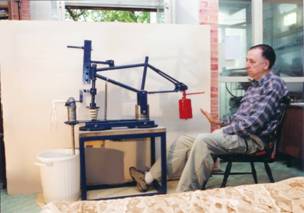 The
research work of Veljko MilkoviŠ followed a single line since he was five,
when, during play, he made a first model of two-stage oscillator. Most of
his later inventions,
which were technically much more advanced, were based on two-stage
oscillators. Two-stage or multi-stage oscillator itself is
a potential perpetuum mobile and an antigravitational motor. The results
of the research on an antigravitational motor Veljko MilkoviŠ described
in the following books: "Towards antigravitation
- compact vehicles" (1994) and "Antigravitational motor"
(1996). After publishing of these two books, MilkoviŠ turned
to use of a two-stage oscillator in the production of mechanical and electrical
energy.
The
research work of Veljko MilkoviŠ followed a single line since he was five,
when, during play, he made a first model of two-stage oscillator. Most of
his later inventions,
which were technically much more advanced, were based on two-stage
oscillators. Two-stage or multi-stage oscillator itself is
a potential perpetuum mobile and an antigravitational motor. The results
of the research on an antigravitational motor Veljko MilkoviŠ described
in the following books: "Towards antigravitation
- compact vehicles" (1994) and "Antigravitational motor"
(1996). After publishing of these two books, MilkoviŠ turned
to use of a two-stage oscillator in the production of mechanical and electrical
energy.
The inventions of Veljko MilkoviŠ did not get much response
among experts. MilkoviŠ did receive awards
on certain shows, but most experts approached the inventions with restraint.
Acknowledgments were more the result of the fact that MilkoviŠ's basic model
is a new form of a simple machine. It is also strange that this simple machine
has not been utilised so far, since it could have been made thousands of
years ago. If that was the case, present civilisation would look completely
different. The reason for this delay is probably that such an occurrence
is either non-existing in nature, or hardly noticeable.
When MilkoviŠ made a technically clear and convincing model,
two-armed lever with a physical pendulum,
he asked experts and scientists for
their opinion. The model was exhibited for numerous people
to see, on several fairs. The opinions were divided on the efficient coefficient
of the device. The law on energy sustainability did not allow for
the efficiency coefficient of the to be larger than the one, and the model
showed the opposite. Everything was pointing to the fact that the
efficiency coefficient was larger than one. Providing exact proof took some
time. Without an appropriate equipment, resourcefulness was not enough.
And, besides, questioning the law on energy sustainability demanded a lot
of effort, which was something the scientists familiar with MilkoviŠ's invention
were not prepared to do.
An important part in the research was played by numerous
associates which MilkoviŠ
had. Their explanations, opinions, graphics, drawings, mathematical conclusions,
suggestions and other technical services sped up the research.
All in all, it turned out that physics, as it currently
is, is two small a ground for MilkoviŠ?s models of the two-stage oscillator,
even though it sounds incredible. That is also the main reason why MilkoviŠ
was waiting for so long for his inventions to be scientifically explained
and accepted.
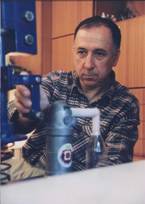
It can be said that MilkoviŠ's models
satisfy the main precondition of the "eternal
motor" - positive balance of energy. The output energy is larger than
the input energy. However, these models are still not autonomous. Gradual
decrease of energy of the primary oscillator, which is usually a physical
pendulum, must be supplemented from outer energy sources. Degree of efficiency
of these machines is larger than one, therefore much larger than with any
other machine, which could not be expected, according to present laws of
physics.

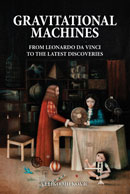
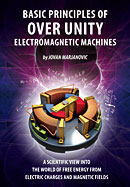





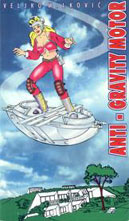
 As
a boy,
As
a boy,  e
of his first invention, he was only 5 years old, and the "Cart
with a pendulum" that have wheels instead of balls was invented
when he was 43, in 1992. This model was the basis for the books in which
he talks about the
e
of his first invention, he was only 5 years old, and the "Cart
with a pendulum" that have wheels instead of balls was invented
when he was 43, in 1992. This model was the basis for the books in which
he talks about the  The
research work of Veljko MilkoviŠ followed a single line since he was five,
when, during play, he made a first model of two-stage oscillator. Most of
his later
The
research work of Veljko MilkoviŠ followed a single line since he was five,
when, during play, he made a first model of two-stage oscillator. Most of
his later 